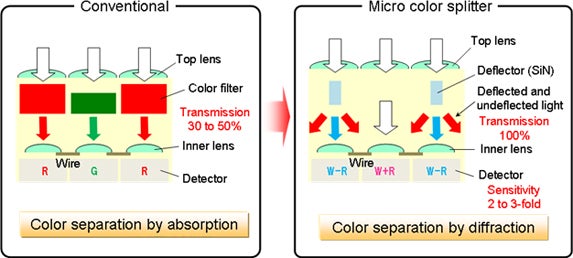Panasonic Creates Color Filter Alternative
By replacing the Bayer color filter array with Micro Color Splitters, Panasonic aims to increase the sensitivity of color imaging sensors

Panasonic has come up with an interesting new answer to capturing color in digital images. The result could allow for higher effective sensitivity for cameras– perhaps 2 to 3 times more– if Panasonic is able to implement the idea in consumer-level devices.
According to a press release on the company’s website its engineers have figured out a way to use micro color splitters (think teeny tiny prism-like lenses) to break white light out into red, green, and blue parts and spread those parts out across pixels. The idea is to use an array of these micro color splitters in place of the Bayer color filter array (or X-Trans color filter in Fujifilm X series cameras) found in most digital cameras.
The Bayer array places color filters in a regular four-pixel pattern over the pixels of an imaging sensor. After the image is captured, the colors in the resulting digital image are interpolated and applied to the image. Panasonic seems to have figured out a way to precisely disperse the colored light that comes out of their micro color splitters so that they can apply a similar type of interpolation on the images captured by their new system. The filters employed in the Bayer (and X-Trans) method consume a substantial amount of light before it reaches the sensor, so there’s a potential for improvement in terms of sensitivity. The new Panasonic method claims to pass the vast majority of that light through to the sensor. The difference is demonstrated below.

In an article called Efficient Colour Splitters for High-Pixel-Density Image Sensors, in the February 2013 issue of the journal Nature Photonics and excerpted in Panasonic’s press release, the company points to three major reasons that they were able to come up with this solution to color capture. The first involved the development of a new way to “allow the precise modeling of optical phenomena such as reflection, refraction, and diffraction.” The second involved “the creation of micro color splitters that control the phase of the light passing through a transparent and highly-refractive plate-like structure and use diffraction to separate colors on a microscopic scale.” The third involved creating a way of creating a layout of the overlapping colors that will land on pixels as a result of the splitting as well as a method to process the information captured by the pixels into colors– basically a substitute for the Bayer array pattern and interpolation algorithm.
From: DP Review